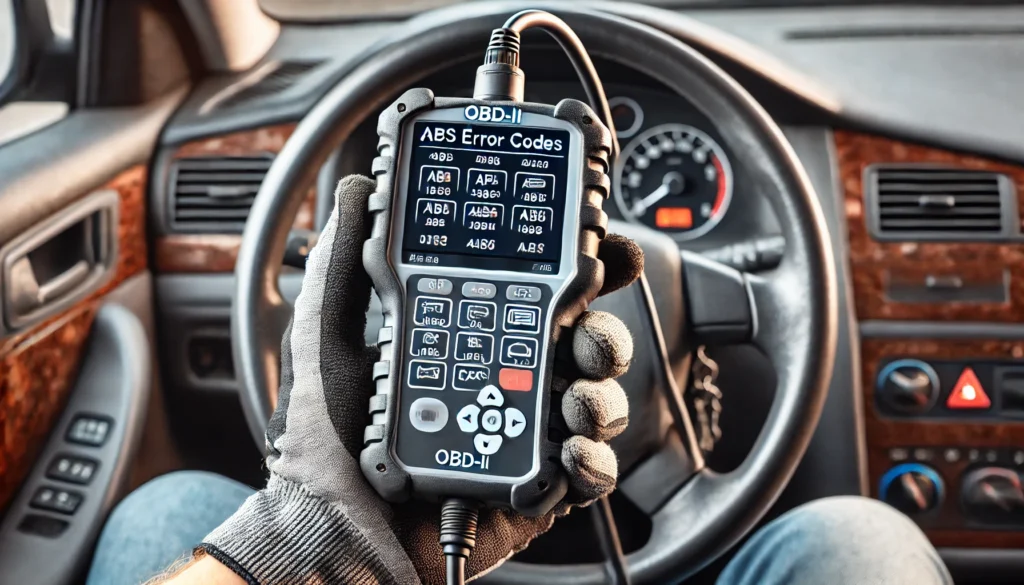The Anti-lock Braking System (ABS) is a vital safety feature in modern vehicles, preventing the wheels from locking up during braking and helping maintain steering control. When the ABS system malfunctions, the vehicle’s computer generates specific error codes that can be read using an OBD-II (On-Board Diagnostics) scanner. Understanding these error codes is crucial for diagnosing and fixing ABS faults.
Common ABS Error Codes
- C0035 – C0051: Wheel Speed Sensor Issues
- Description: These codes indicate problems with the wheel speed sensors, which are essential for monitoring wheel speed and providing data to the ABS control module.
- Common Causes: Dirty, damaged, or faulty sensors, and wiring issues.
- Solution: Inspect and clean the sensors; replace any damaged sensors or repair faulty wiring.

- C0131 – C0136: ABS Module and System Performance Issues
- Description: These codes relate to the ABS control module’s performance and the overall system functionality.
- Common Causes: Faulty ABS control module, software issues, or poor electrical connections.
- Solution: Diagnose the ABS control module for faults; reprogram or replace the module if necessary; check and secure all electrical connections.
- C0110: Pump Motor Circuit Malfunction
- Description: Indicates a problem with the ABS pump motor circuit, which helps maintain brake pressure during ABS operation.
- Common Causes: Faulty pump motor, wiring issues, or a blown fuse.
- Solution: Inspect and repair or replace the pump motor; check the wiring and fuse.
- C0121: Valve Relay Circuit Malfunction
- Description: This code points to an issue with the valve relay circuit, responsible for controlling the hydraulic valves that regulate brake pressure.
- Common Causes: Faulty relay, wiring problems, or a malfunctioning ABS control module.
- Solution: Test and replace the relay if necessary; inspect and repair wiring; check the ABS control module.

- C0265: EBCM Relay Circuit
- Description: Refers to a malfunction in the Electronic Brake Control Module (EBCM) relay circuit.
- Common Causes: Electrical issues within the EBCM, relay faults, or poor connections.
- Solution: Inspect the EBCM for faults; replace the relay if necessary; ensure all connections are secure and free of corrosion.
Diagnosing ABS Faults Using OBD-II Codes
- Connect the OBD-II Scanner:
- Locate the OBD-II port, usually under the dashboard, and connect the scanner.
- Turn the ignition on but do not start the engine.
- Read Error Codes:
- Use the scanner to read the stored error codes related to the ABS system.
- Note down the codes for reference.
- Interpret the Codes:
- Refer to the scanner’s manual or an online database to interpret the codes.
- Each code provides a specific indication of what part of the ABS system is malfunctioning.
- Perform Necessary Repairs:
- Based on the error codes, inspect and repair or replace the faulty components.
- Clear the codes using the scanner after repairs to ensure the issue is resolved.
Importance of Addressing ABS Faults
Ignoring ABS fault codes can lead to serious safety risks, as the ABS system plays a crucial role in maintaining vehicle control during emergency braking. Regularly checking and addressing these error codes helps ensure that the ABS system functions correctly, enhancing overall vehicle safety.
Conclusion
Understanding and interpreting ABS error codes is essential for diagnosing and repairing faults in the Anti-lock Braking System. Common codes such as C0035 (wheel speed sensor issues) and C0110 (pump motor circuit malfunction) point to specific problems that need to be addressed to maintain optimal braking performance. Using an OBD-II scanner to read these codes allows for accurate diagnosis and timely repairs, ensuring your vehicle remains safe and reliable.